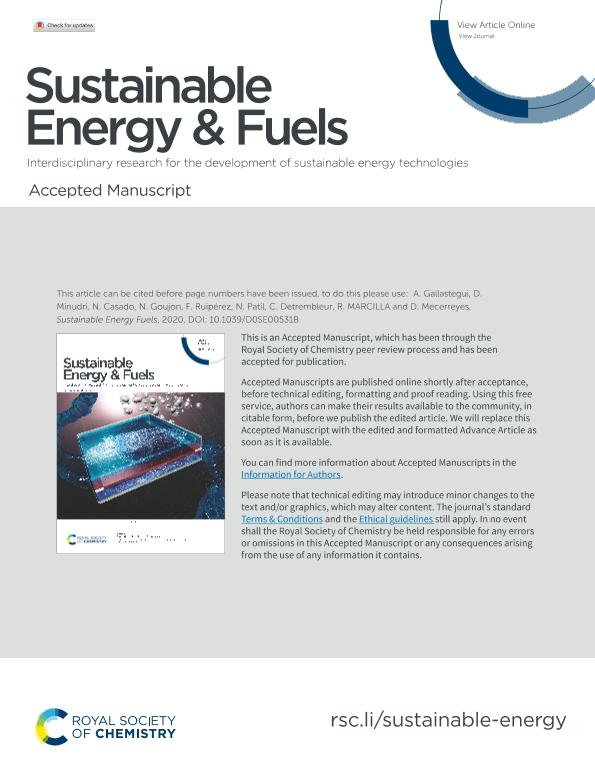Mostrar el registro sencillo del ítem
dc.contributor.author
Gallastegui, Antonela

dc.contributor.author
Minudri, Daniela

dc.contributor.author
Casado, Nerea

dc.contributor.author
Goujon, Nicolas

dc.contributor.author
Ruipérez, Fernando

dc.contributor.author
Patil, Nagaraj

dc.contributor.author
Detrembleur, Christophe

dc.contributor.author
Marcilla, Rebeca

dc.contributor.author
Mecerreyes, David
dc.date.available
2021-10-05T14:25:14Z
dc.date.issued
2020-08-02
dc.identifier.citation
Gallastegui, Antonela; Minudri, Daniela; Casado, Nerea; Goujon, Nicolas; Ruipérez, Fernando; et al.; Proton trap effect on catechol-pyridine redox polymer nanoparticles as organic electrodes for lithium batteries; Royal Society of Chemistry; Sustainable Energy and Fuels; 4; 8; 2-8-2020; 3934-3942
dc.identifier.issn
2398-4902
dc.identifier.uri
http://hdl.handle.net/11336/142669
dc.description.abstract
Organic redox-active materials are actively being searched as a more sustainable alternative to traditional inorganic cathodes used in rechargeable batteries. Among the different types of organic cathodes, redox polymers based on catechol groups show high energy storage capacities. In this article, we show how the introduction of pyridine groups can shift the potential of catechol containing polymers towards more positive values further enhancing their energy storage capacities. For this purpose, we carried out the synthesis of redox-active polymer nanoparticles having catechol and pyridine functionalities. Spherical nanoparticles between 150 and 300 nm were synthesized by a surfactant-free emulsion polymerization method by copolymerization of dopamine methacrylamide and 4-vinyl pyridine. The chemical composition of the nanoparticles was confirmed by FTIR spectroscopy which shows the presence of catechol-pyridine hydrogen bonding. Thermal analyses (DSC, TGA) confirmed the glass transition of the nanoparticles between 158 and 190 °C and high thermal stability with a degradation temperature of 300 °C at 5% weight loss (Td5%). The electrochemical characterization of the redox-active polymer nanoparticles show that the redox potential of the catechol group was not affected by the presence of the pyridine in acidic electrolytes (E1/2 = 0.45 V versus Ag/AgCl). However, in organic electrolytes containing a lithium salt the redox potential of the catechol nanoparticles shifted from 0.27 V for catechol homopolymer, to 0.56 V for the catechol-pyridine copolymer. This positive potential gain could be associated to the proton trap effect as indicated by DFT calculations. Finally, the beneficial effect of the proton trap effect onto the performance of lithium-ion-polymer battery was demonstrated. The lithium vs. polymer cells showed a promising practical high voltage organic cathode (3.45 V vs. Li+/Li), excellent rate performance (up to 120C) and high capacity retention after cycling (74% after 800 cycles).
dc.format
application/pdf
dc.language.iso
eng
dc.publisher
Royal Society of Chemistry

dc.rights
info:eu-repo/semantics/openAccess
dc.rights.uri
https://creativecommons.org/licenses/by-nc/2.5/ar/
dc.subject
Proton trap
dc.subject
Redox active
dc.subject
Lithium batteries
dc.subject
Catechol
dc.subject.classification
Físico-Química, Ciencia de los Polímeros, Electroquímica

dc.subject.classification
Ciencias Químicas

dc.subject.classification
CIENCIAS NATURALES Y EXACTAS

dc.title
Proton trap effect on catechol-pyridine redox polymer nanoparticles as organic electrodes for lithium batteries
dc.type
info:eu-repo/semantics/article
dc.type
info:ar-repo/semantics/artículo
dc.type
info:eu-repo/semantics/publishedVersion
dc.date.updated
2021-09-29T14:50:53Z
dc.journal.volume
4
dc.journal.number
8
dc.journal.pagination
3934-3942
dc.journal.pais
Reino Unido

dc.journal.ciudad
Londres
dc.description.fil
Fil: Gallastegui, Antonela. Universidad Nacional de Río Cuarto. Facultad de Ciencias Exactas Fisicoquímicas y Naturales. Instituto de Investigaciones en Tecnologías Energéticas y Materiales Avanzados. - Consejo Nacional de Investigaciones Científicas y Técnicas. Centro Científico Tecnológico Conicet - Córdoba. Instituto de Investigaciones en Tecnologías Energéticas y Materiales Avanzados; Argentina
dc.description.fil
Fil: Minudri, Daniela. Universidad Nacional de Río Cuarto. Facultad de Ciencias Exactas Fisicoquímicas y Naturales. Instituto de Investigaciones en Tecnologías Energéticas y Materiales Avanzados. - Consejo Nacional de Investigaciones Científicas y Técnicas. Centro Científico Tecnológico Conicet - Córdoba. Instituto de Investigaciones en Tecnologías Energéticas y Materiales Avanzados; Argentina
dc.description.fil
Fil: Casado, Nerea. Universidad del País Vasco. Polymat; España
dc.description.fil
Fil: Goujon, Nicolas. Universidad del País Vasco. Polymat; España
dc.description.fil
Fil: Ruipérez, Fernando. Universidad del País Vasco. Polymat; España
dc.description.fil
Fil: Patil, Nagaraj. Instituto Imdea Energia; España
dc.description.fil
Fil: Detrembleur, Christophe. Universidad de Lieja; Bélgica
dc.description.fil
Fil: Marcilla, Rebeca. Instituto Imdea Energia; España
dc.description.fil
Fil: Mecerreyes, David. Universidad del País Vasco. Polymat; España. Ikerbasque; España
dc.journal.title
Sustainable Energy and Fuels
dc.relation.alternativeid
info:eu-repo/semantics/altIdentifier/url/https://pubs.rsc.org/en/content/articlelanding/2020/SE/D0SE00531B
dc.relation.alternativeid
info:eu-repo/semantics/altIdentifier/doi/http://dx.doi.org/10.1039/D0SE00531B
Archivos asociados
